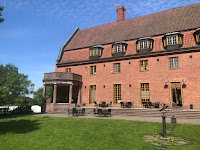 Last Oracle Open World, Pasi Jaakkola the President of the Finnish User Group asked me if I would like to give an Applications keynote at their 2018 conference, their 30th Anniversary.
Last Oracle Open World, Pasi Jaakkola the President of the Finnish User Group asked me if I would like to give an Applications keynote at their 2018 conference, their 30th Anniversary. I have spoken for this usergroup twice before, their 20th Anniversary Event and as part of an OTN Nordic Tour in 2014.
This year the event was held in Vanajanlinna just over an hour from Helsinki. Not only was it a fantastic location but it was unseasonably hot for Finland and just wonderful. I had a suite overlooking the lake and would love to take a holiday there sometime.
They provided a bus from the airport and we were given a little tour of the countryside including a visit to Pasi's home where we drank champagne as his family played music for us.
I had three presentations:
- My keynote - Cloud Applications, back to basics
- Extending Cloud Applications with VBCS
- Should I move to Cloud Applications, route to the Cloud
The Back to Basics session was the first of the conference, and as is common in Europe it was a predominately technical audience but they did seem interested. I talked about how the technology enabled the application and what components were used. I know Oracle tell you it doesn't matter, you are buying or rather subscribing to a solution, but organisations who have had on premise applications do want to know.
And even if the audience are not Oracle applications users, the principles of design are relevant to any development. As ever to me the measure of success was the number of questions I had, both during and after the presentation.
 After lunch I had my other two presentations, one after the other. The VBCS presentation was the first time I had used release 2 in a session and on the whole it behaved well, except for a small glitch at the very end on the mobile app. I had been more concerned about the wifi which had been patchy, but all worked out well. I really enjoy this presentation as I can make it relevant to the event, so we collected data on those intending to use the sauna.
After lunch I had my other two presentations, one after the other. The VBCS presentation was the first time I had used release 2 in a session and on the whole it behaved well, except for a small glitch at the very end on the mobile app. I had been more concerned about the wifi which had been patchy, but all worked out well. I really enjoy this presentation as I can make it relevant to the event, so we collected data on those intending to use the sauna.
And even if the audience are not Oracle applications users, the principles of design are relevant to any development. As ever to me the measure of success was the number of questions I had, both during and after the presentation.
 After lunch I had my other two presentations, one after the other. The VBCS presentation was the first time I had used release 2 in a session and on the whole it behaved well, except for a small glitch at the very end on the mobile app. I had been more concerned about the wifi which had been patchy, but all worked out well. I really enjoy this presentation as I can make it relevant to the event, so we collected data on those intending to use the sauna.
After lunch I had my other two presentations, one after the other. The VBCS presentation was the first time I had used release 2 in a session and on the whole it behaved well, except for a small glitch at the very end on the mobile app. I had been more concerned about the wifi which had been patchy, but all worked out well. I really enjoy this presentation as I can make it relevant to the event, so we collected data on those intending to use the sauna. Then my final session was the 'route to cloud' that I gave not too long ago as community keynote in Dublin, and based on my Oracle Scene article at the end of last year. This prompted some questions around data centres and organisational strategies especially around cloud @ customer.
Part of the reason I had such a great day was that the audience were interactive. Also there were some great speakers who asked questions and added answers to the conversation.
 That evening after a wonderful dinner it was time to enjoy the grounds of this amazing location. Finland is so far north it was way past 11pm before it was dark, and such a great time to relax and get to know people.
That evening after a wonderful dinner it was time to enjoy the grounds of this amazing location. Finland is so far north it was way past 11pm before it was dark, and such a great time to relax and get to know people.The Wednesday I had finished my sessions. Pasi works for Accenture, who you will remember have just acquired Certus and their global lead for the database, a fellow ACE Director Julian Dontcheff is also based in Finland. Also speaking were new colleagues from Enkitec and in total about 10 Accenture people in attendance so I was able to learn a bit more about how the company and specifically Oracle work.
This was a great conference, and I loved that I was able to present something new to a traditional audience and yet they all learnt and appreciated. The location was amazing and I'll certainly be back.






